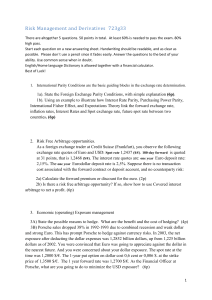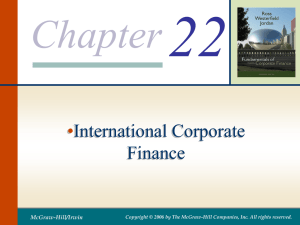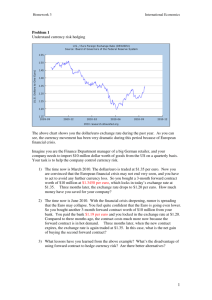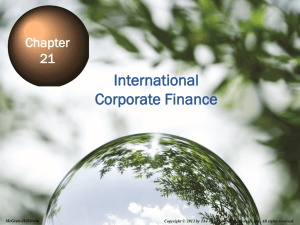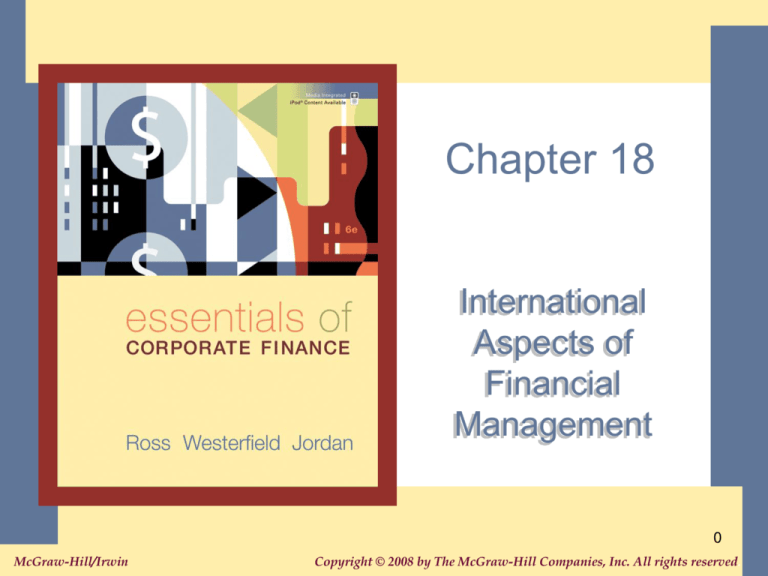
Chapter 18
International
Aspects of
Financial
Management
0
McGraw-Hill/Irwin
Copyright © 2008 by The McGraw-Hill Companies, Inc. All rights reserved.
1-118-1
Key Concepts and Skills
• Understand how exchange rates are quoted
and what they mean
• Know the difference between spot and forward
rates
• Understand purchasing power parity and
interest rate parity and the implications for
changes in exchange rates
• Understand the types of exchange rate risk
and how it can be managed
• Understand the impact of political risk on
international business investing
1
1-218-2
Chapter Outline
• Terminology
• Foreign Exchange Markets and Exchange
Rates
• Purchasing Power Parity
• Exchange Rates and Interest Rates
• Exchange Rate Risk
• Political Risk
2
1-318-3
Domestic Financial Management and
International Financial Management
• Considerations in International Financial
Management
– Have to consider the effect of exchange rates
when operating in more than one currency
– Have to consider the political risk associated with
actions of foreign governments
– More financing opportunities when you consider
the international capital markets and this may
reduce the firm’s cost of capital
3
International Finance
Terminology
•
•
•
•
•
•
•
•
1-418-4
American Depositary Receipt (ADR)
Cross-rate
Eurobond
Eurocurrency (Eurodollars)
Foreign bonds
Gilts
London Interbank Offer Rate (LIBOR)
Swaps
4
1-518-5
Global Capital Markets
• The number of exchanges in foreign countries
continues to increase, as does the liquidity on
those exchanges
• Exchanges that facilitate the flow of capital
are extremely important to developing
countries
• The United States has one of the most
developed capital markets in the world, but
foreign markets are becoming more
competitive, and they are often willing to try
more innovative ways to do business
5
1-618-6
Example: Work the Web
• Thinking about going to Mexico for spring
break or Japan for your summer vacation?
• How many pesos or yen can you get in
exchange for $1,000?
• Click on the Web surfer to find out
6
1-718-7
Exchange Rates
• The price of one country’s currency in terms of
another
• Most currency is quoted in terms of dollars
• Consider the following quote:
– Euro
1.34922
.74117
– The first number (1.34922) is how many U.S.
dollars it takes to buy 1 euro
– The second number (. 74117) is how many
euros it takes to buy U.S.$1
– The two numbers are reciprocals of each other
(1/. 74117 = 1.34922)
7
1-818-8
Example: Exchange Rates
• Suppose you have $10,000 . Based on the
rates in Figure 18.1, how many Norwegian
Krone can you buy?
– Exchange rate = 6.2461 Krone per U.S. dollar
– Buy 10,000(6.2461) = 62,461 Krone
• Suppose you are visiting London and you
want to buy a souvenir that costs 1,000 British
pounds. How much does it cost in U.S.
dollars?
– Exchange rate = $1.9669 dollars per pound
– Cost = 1,000 X 1.9669 = $1,966.90
8
1-918-9
Example: Triangle Arbitrage
• We observe the following fictitious quotes:
– 1 Euro per $1
– 2 Swiss Franc per $1
– .4 Euro per 1 Swiss Franc
• What is the cross rate?
– (1 Euro / $1) / (2 SF / $1) = .5 Euro / SF
• We have $100 to invest; buy low, sell high
– Buy $100(1 Euro/$1) = 100 Euro, use Euro to buy
SF
– Buy 100 Euro / (.4 Euro / 1 SF) = 250 SF, use SF
to buy dollars
– Buy 250 SF / (2 SF/$1) = $125
– Make $25 risk-free
9
1-10
18-10
Transaction Terminology
• Spot trade – exchange currency immediately
– Spot rate – the exchange rate for an
immediate trade
• Forward trade – agree today to exchange
currency at some future date and some
specified price (also called a forward
contract)
– Forward rate – the exchange rate specified in
the forward contract
– If the forward rate is higher than the spot
rate, the foreign currency is selling at a
premium (when quoted as $ equivalents)
– If the forward rate is lower than the spot rate,
the foreign currency is selling at a discount
10
1-11
18-11
Absolute Purchasing Power Parity
• Price of an item is the same regardless
of the currency used to purchase it
• Requirements for absolute PPP to hold
– Transaction costs are zero
– No barriers to trade (no taxes, tariffs, etc.)
– No difference in the commodity between
locations
• Absolute PPP rarely holds in practice for
many goods
11
1-12
18-12
Relative Purchasing Power Parity
• Provides information about what causes
changes in exchange rates
• The basic result is that exchange rates
depend on relative inflation between
countries
• E(St ) = S0[1 + (hFC – hUS)]t
• Because absolute PPP doesn’t hold for
many goods, we will focus on relative
PPP from here on
12
1-13
18-13
Example: PPP
• Suppose the Canadian spot exchange rate is
1.18 Canadian dollars per U.S. dollar. U.S.
inflation is expected to be 3% per year and
Canadian inflation is expected to be 2%.
– Do you expect the U.S. dollar to appreciate or
depreciate relative to the Canadian dollar?
• Since expected inflation is higher in the U.S., we would
expect the U.S. dollar to depreciate relative to the
Canadian dollar.
– What is the expected exch. rate in one year?
• E(S1) = 1.18[1 + (.02 - .03)]1 = 1.1682
13
1-14
18-14
Covered Interest Arbitrage
• Examine the relationship between spot
rates, forward rates, and nominal rates
between countries
• Again, the formulas will assume that the
exchange rates are quoted in terms of
foreign currency per U.S. dollar
• The U.S. risk-free rate is assumed to be
the T-bill rate
14
1-15
18-15
Example: Covered Interest Arbitrage
• Consider the following information
– S0 = .8 Euro / $
– F1 = .7 Euro / $
RUS = 4%
RE = 2%
• What is the arbitrage opportunity?
– Borrow $100 at 4%
– Buy $100(.8 Euro/$) = 80 Euro and invest at
2% for 1 year
– In 1 year, receive 80(1.02) = 81.6 Euro and
convert back to dollars
– 81.6 Euro / (.7 Euro / $) = $116.57 and repay
loan
– Profit = 116.57 – 100(1.04) = $12.57 risk free15
1-16
18-16
Interest Rate Parity
• Based on the previous example, there
must be a forward rate that would
prevent the arbitrage opportunity.
• Interest rate parity defines what that
forward rate should be
F1
(1 RFC )
Exact :
S0
(1 RUS )
F1
Approx. :
1 ( RFC RUS )
S0
16
1-17
18-17
Short-Run Exposure
• Risk from day-to-day fluctuations in
exchange rates and the fact that
companies have contracts to buy and
sell goods in the short-run at fixed prices
• Managing risk
– Enter into a forward agreement to
guarantee the exchange rate
– Use foreign currency options to lock in
exchange rates if they move against you,
but benefit from rates if they move in your
favor
17
1-18
18-18
Long-Run Exposure
• Long-run fluctuations come from
unanticipated changes in relative
economic conditions
• Could be due to changes in labor
markets or governments
• More difficult to hedge
• Try to match long-run inflows and
outflows in the currency
• Borrowing in the foreign country may
mitigate some of the problems
18
1-19
18-19
Translation Exposure
• Income from foreign operations has to be
translated back to U.S. dollars for accounting
purposes, even if foreign currency is not
actually converted back to dollars
• If gains and losses from this translation flowed
through directly to the income statement,
there would be significant volatility in EPS
• Current accounting regulations require that all
cash flows be converted at the prevailing
exchange rates with currency gains and
losses accumulated in a special account
within shareholders’ equity
19
1-20
18-20
Managing Exchange Rate Risk
• Large multinational firms may need to
manage the exchange rate risk
associated with several different
currencies
• The firm needs to consider its net
exposure to currency risk instead of just
looking at each currency separately
• Hedging individual currencies could be
expensive and may actually increase
exposure
20
1-21
18-21
Political Risk
• Changes in value due to political actions in the
foreign country
• Investment in countries that have unstable
governments should require higher returns
• The extent of political risk depends on the
nature of the business
– The more dependent the business is on other
operations within the firm, the less valuable it is to
others
– Natural resource development can be very
valuable to others, especially if much of the
ground work in developing the resource has
already been done
• Local financing can often reduce political risk
21
1-22
18-22
Quick Quiz
• What does an exchange rate tell us?
• What is triangle arbitrage?
• What are absolute purchasing power parity
and relative purchasing power parity?
• What are covered interest arbitrage and
interest rate parity?
• What is the difference between short-run
interest rate exposure and long-run interest
rate exposure? How can you hedge each
type?
• What is political risk and what types of
business face the greatest risk?
22
1-23
18-23
Comprehensive Problem
• Assume that one U.S. dollar buys 115
Japanese Yen, and one U.S. dollar buys
.54 Pound Sterling.
• What must the dollar – pound exchange
rate be in order to prevent triangular
arbitrage (ignore transaction costs)?
23

